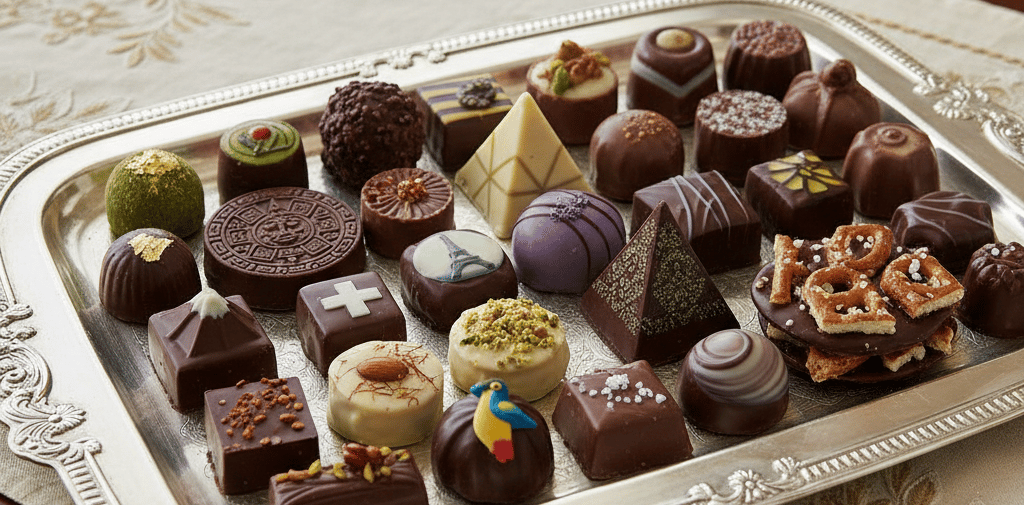A World of Chocolate
How Different Cultures Transform Cacao Into Something Singular


Chocolate may be one of the most universally loved foods on Earth, yet no two countries craft it quite the same way. The humble cacao bean—once a bitter drink reserved for kings, warriors, and rituals—travels through thousands of hands and hundreds of traditions before it becomes the silky bar, crunchy praline, or aromatic drink we know today. What emerges from this journey is an astonishing global tapestry of flavors, textures, and techniques that many chocolate lovers never realize exist.
In other words: chocolate is not just a treat—it’s geography, history, and culture wrapped in foil.
Europe: Precision, Prestige, and the Pursuit of Smoothness
Europe’s chocolate tradition is so iconic today that many people are shocked to learn this region didn’t even encounter cacao until the 1500s. But once it arrived, Europe elevated it into a culinary art form.
Belgium
Belgium is renowned for its meticulous conching—a process that grinds chocolate so finely that it melts on the tongue in seconds. Belgian chocolatiers are also credited with inventing the modern praline in 1912, transforming filled chocolates from a luxury into a global phenomenon.
Switzerland
The Swiss, meanwhile, invented milk chocolate as we know it today. Daniel Peter, struggling to make a soft caramel treat, blended condensed milk into his chocolate mixture in 1875 and accidentally birthed a new era of creamy indulgence. Swiss chocolate’s signature “ultra-smoothness” comes from extremely long conching times—sometimes up to 72 hours.
France
French chocolatiers often approach chocolate the way they approach wine: emphasizing terroir, balance, and sensory experience. Dark chocolate dominates, often with flavor profiles designed to evolve from first bite to finish like a fine Bordeaux.
Latin America: The Ancient Homeland of Cacao
If Europe refined chocolate, Latin America created it.
Cacao has been cultivated here for over 5,000 years, and remnants of chocolate beverages have been found in Olmec pottery dating back to 1500 BCE. The Maya and Aztecs drank cacao during ceremonies, marriages, and even military rituals—sometimes mixed with chile, honey, vanilla, or flowers.
Ecuador
Ecuador’s prized Nacional cacao was once believed extinct until a small grove was rediscovered in 2010. This bean produces astonishing natural flavors—notes of floral jasmine, ripe banana, and warm spices.
Peru
Peru grows more cacao biodiversity than almost anywhere else on the planet. Its beans often have natural notes of citrus, berries, and dried fig, making Peruvian chocolate a favorite among craft makers.
Mexico
Mexican-style chocolate is still traditionally stone-ground, giving it a rustic texture and a deep, earthy aroma. It often includes cinnamon or chile—flavors that mirror chocolate’s earliest documented recipes.
Asia: Innovation, Refinement, and Surprise
Asia’s chocolate renaissance is far newer, but also one of the most exciting.
Japan
Japan has become a global powerhouse in chocolate innovation. Each Valentine’s season, Japanese chocolatiers debut avant-garde creations—bonbons flavored with roasted hojicha tea, rare Japanese citrus like yuzu or sudachi, or even black sesame praline. International chocolatiers often test new flavors in Tokyo because the market embraces experimentation.
Vietnam & India
Vietnam’s cacao industry is rapidly growing, producing bars with bright, fruity acidity. India is also seeing a tree-to-bar movement flourish, with makers highlighting regional spices, coffee, and native fruits.
Here’s a wow fact:
One Indian maker, Soklet, grows cacao in the foothills of the Anamalai Mountains on land shared with wild elephants. Their bars carry subtle hints of the surrounding rainforest.
The United States: Bold, Diverse, and Fearlessly Experimental
American chocolate was once known primarily for mass-produced candy bars—but the U.S. craft chocolate wave has become one of the world’s most influential.
Small-batch makers embrace high cocoa percentages, single-origin sourcing, and nontraditional inclusions. Think:
Smoked sea salt
Brown butter
Lavender and honey
Chili-lime
Maple sugar
Bourbon-barrel-aged cacao nibs
The U.S. also helped fuel the global push for transparency in cacao farming—publishing farming origins, fermentation methods, and direct-trade practices right on the packaging.
Here’s another fun fact!
Some American bars contain only two ingredients—cacao and sugar—mirroring how chocolate tasted hundreds of years ago.
Contact
info@menloparkchocolatecompany.com
© 2025 Menlo Park Chocolate Company. All rights reserved.
Subscribe to receive special offers and to hear about new product drops!
